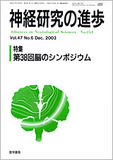Japanese
English
- 有料閲覧
- Abstract 文献概要
これまで克服困難とされてきた様々な中枢神経疾患に対する将来の有望な治療法の一つとして,神経幹細胞を用いて損傷組織内に新たなニューロンを供給する再生医療が,最近大きな注目を集めている1)。
幹細胞の応用法としては,現在世界的に精力的な研究が展開されている外来細胞の移植療法の他に,もともと成体の神経組織に残存する幹細胞のもつ,潜在的な再生能力を利用する再生誘導療法がある。筆者らは,種々の病態モデル動物を用いて,成体の脳・脊髄に残存する神経幹細胞を用いた再生誘導の可能性を模索している2-4)。ここでは,ラットを用いた虚血脳損傷後の海馬ニューロンの再生誘導と,脳機能回復に関する筆者らの最近の取り組みを中心に紹介する2)。
It has long been believed that the adult mammalian brain is incapable of significant self-repair or regeneration. Many lines of recent studies have revealed, however, that neural stem cells and other types of progenitors persist throughout life in various mammalian species including humans. This emerging evidence has overturned the log-held dogma, and raises the novel possibility that dormant capacities of endogenous progenitors may be recruited to generate new functional neurons and repair the damaged brain. Here I provide evidence for a remarkable rege-nerative capacity of adult neural progenitors upon focusing on the hippocampus. The adult hippocampus, a vital center for learning and memory, is extremely vulnerable to ischemic and other brain insults. We found that following transient global ischemia in rats, intraventricular infusion of growth factors at a critical timing and position can stimulate adult progenitors in situ to replace CA1 pyramidal neurons and other hippocampal neuronal subtypes lost to ischemic damage. Morphological and electrophysiological studies demonstrated that these newly generated CA1 neurons form functional synapses, and are integrated into the existing brain circuitry. In parallel to the massive induction of new hippocampal neurons, the growth factor treatment ameliorated deficits in hippocampal-dependent spatial cognitive functions in ischemic animals. These findings thus expand the possibility of a novel neuronal replacement therapy for stroke, and potentially also for other neurological diseases.
Copyright © 2003, Igaku-Shoin Ltd. All rights reserved.


